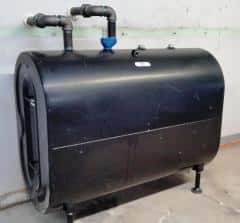By Brian Gray

The biggest challenge for homeowners in meeting these new regulations is that Vermont has many older homes with tanks that were installed well before any of the new rules were even considered. Older tanks deteriorate over time based on many factors. In general, the typical lifespan of a heating oil tank is about 20 years and should be replaced well before a problem develops.
Many oil tank leaks are caused by corrosion that has occurred somewhere in the tank. Typically, corrosion is due to a buildup of water due to condensation within the tank. This occurs when the tank is not kept full and the temperature outside changes. Many times, the corrosion happens from the inside of the tank so even if your tank looks in good shape from the outside it may have significant corrosion on the inside.
The most common oil tanks in Vermont hold 275 gallons of oil or kerosene. If you have a larger home, you may have two tanks joined together to provide double the capacity. In cold regions like Vermont, it’s not recommended to install oil tanks outdoors or in unheated space such as garages. This is because heating oil begins to gel at about 20°F and at lower temperatures it won’t flow to the burner. So, the best place for a heating oil tank is in a heated basement with plenty of air circulation.
Kerosene can be stored in outdoor tanks because it has a lower “gel point” than heating oil. Many condominiums and mobile homes are heated with space heaters or furnaces that burn kerosene supplied from outdoor tanks.
One of the most important things to know about the new regulations is that homeowners are now required to have their oil tanks officially inspected every three years by a certified inspector. Fuel companies are required to inspect the homeowner’s fuel tank prior to delivering fuel to every new customer. These five conditions must be in compliance for a tank to be deemed “Acceptable for Delivery”:
1. All four legs of the tank are located on a stable foundation
2. The tank and tank legs are free of any cracks, significant corrosion, pitting, rust, dents or bulges; and all tank fuel filters, fittings, and valves are free of drips or leaks and any other sign of an actual or suspected leak
3. All tank fuel lines that are buried in dirt or concrete (below grade) are installed in a plastic coating OR protective sleeve made of non-corrodible material
4. The tank shall have a vent alarm or “whistle” that terminates within 12 feet and is visible from the fill pipe
5. The fill pipe and the vent pipe shall be at least 1-1/4 inches in diameter. The fill pipe shall have a liquid-tight cap and the vent pipe shall have a weatherproof and insect-proof cap.
If any one of these items are not in compliance, the Inspector will put the tank out of service and issue a “Red Tag”. A “Red Tag” is a notification to all fuel dealers and to the State of Vermont that the tank is not compliant and that improvements must be made to the tank or piping before any fuel dealer can make a delivery. A public database of Tanks that are red tagged is maintained by the State of Vermont. If you have been red tagged, once the tank has been repaired or replaced and re-inspected, the Inspector will remove the red tag, remove the tank from the State database and deliveries may resume by your fuel dealer.
Oil tanks need very little maintenance during their expected twenty-year lifetime. We recommend an annual tune-up and oil line filter replacement for oil-fired heating. This will keep your burner free from any solids that may build up in the bottom of the tank. Outside of an annual tune up, call a technician if you see:
• Oil spots under the tank
• Bent or buckled tank legs
• Dark spots which may indicate oil migrating to the outside of the tank
You can help extend the life of your oil or kerosene tank – especially if it is an outside tank – by keeping the tank full during the summer months. This reduces condensation and water build-up, one of the main contributors to oil tank corrosion.
If you have a buried underground oil tank, especially one that has been in place for twenty years or more, you should consider replacing it with a new basement tank. Through the Petroleum Clean-Up Fund, VT’s Department of Environmental Conservation (DEC) offers Vermont homeowners grants of up to $3,000 towards the cost of removing, replacing or upgrading both underground and above ground residential heating oil tanks
If your home has been converted to natural gas, the regulations require that you remove your oil tank at the time of conversion. When you do so, it’s recommended that the tank be as empty as possible before removal to reduce the chance of fuel spillage. So, if you are transitioning, try to burn as much of the fuel in your tank as possible before you install a new system.
The Energy Co-op of Vermont inspects oil tanks during tune-ups, service calls and before making deliveries to new accounts. Our Service team can replace, remove and repair all issues with above ground fuel tanks. For more information about oil tank repairs, call us at 802-860-4090 or submit a service request.
Helpful links:
State of Vermont Financial assistance resources:
https://dec.vermont.gov/waste-management/storage-tanks/tank-removal-financial-assistance
Tank removal financial assistance:
https://dec.vermont.gov/waste-management/storage-tanks/tank-removal-financial-assistance/ast-removal
Heating fuel stats:
https://www.housingdata.org/profile/housing-stock/home-fuels








